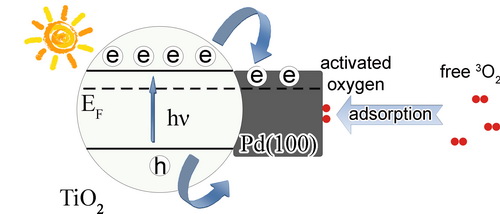XIONG Yujie's group made new progress on the design of hybrid catalysts for organic oxidation reactions, based on their previous finding on metal-oxygen charge transfer in oxygen activation (refer to: J. Am. Chem. Soc. 2013, 135, 3200). In this work, they designed semiconductor-metal hybrid structures with tunable charge density, enabling improved catalytic efficiency for organic oxidation reactions. Teamed up with Prof. Xiaojun Wu and Prof. Qun Zhang, the researchers performed the studies by integrating controlled synthesis with theoretical simulations and advanced characterizations, and discovered the competition behavior and mechanism for charge transfer in oxygen activation. This progress has been published in Angew. Chem. Int. Ed. online (http://onlinelibrary.wiley.com/doi/10.1002/anie.201309660/abstract).
Prior to this work, organic chemists generally consider the function of semiconductor oxides as a catalyst template when used as supports for metal catalysts in organic oxidation. Based on the relationship between surface charge and molecular activation on metal catalysts, the researchers proposed to modulate the metal charge state by building hybrid structures between metal nanocrystals and semiconductor supports, in which their Schottky barrier was designated to drive the photogenerated electrons transferred from semiconductor to metal surface. In this work, they for the first time discovered that surface plasmonics of metal induced the injection of hot electrons into the conduction band of n-type semiconductor and formed a competition with the Schottky-junction-driven charge transfer, employing ultrafast spectroscopy and dynamic measurements as a probe. Upon elucidating the microscopic mechanisms, they have been able to optimize the activities of catalysts in oxygen activation and organic oxidation by simply altering illumination intensity. It is anticipated that the present work casts new light on the importance of semiconductor supports in related reactions, and provides new insights into catalyst design for organic reactions with improved activity by taking electron-matter interactions into account.

Schematic illustrating the molecular oxygen activation in the TiO2-Pd hybrid system
This work was supported by 973 Program, NSFC, Recruitment Program of Global Experts, CAS Hundred Talent Program, and Fundamental Research Funds for the Central Universities
(Hefei National Laboratory for Physical Sciences at the Microscale)